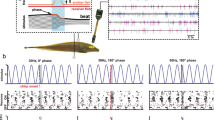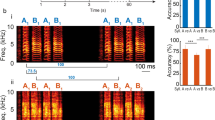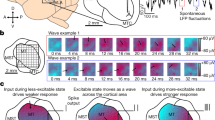Abstract
The gymnotiform weakly electric fish Apteronotus leptorhynchus can capture prey using electrosensory cues that are dominated by low temporal frequencies. However, conventional tuning curves predict poor electroreceptor afferent responses to low-frequency stimuli. We compared conventional tuning curves with information tuning curves and found that the latter predicted substantially improved responses to these behaviorally relevant stimuli. Analysis of receptor afferent baseline activity showed that negative correlations reduced low-frequency noise levels, thereby increasing information transmission. Multiunit recordings from receptor afferents showed that this increased information transmission could persist at the population level. Finally, we verified that this increased low-frequency information is preserved in the spike trains of central neurons that receive receptor afferent input. Our results demonstrate that conventional tuning curves can be misleading when certain noise reduction strategies are used by the nervous system.
This is a preview of subscription content, access via your institution
Access options
Subscribe to this journal
Receive 12 print issues and online access
$209.00 per year
only $17.42 per issue
Buy this article
- Purchase on Springer Link
- Instant access to full article PDF
Prices may be subject to local taxes which are calculated during checkout





Similar content being viewed by others
References
Rieke, F., Warland, D., de Ruyter van Steveninck, R.R. & Bialek, W. Spikes: Exploring the Neural Code (MIT, Cambridge, Massachusetts, USA, 1996).
Borst, A. & Theunissen, F. Information theory and neural coding. Nat. Neurosci. 2, 947–957 (1999).
Holden, A.V. Signal processing: neural coding by correlation? Nature 428, 382 (2004).
Hubel, D.H. & Wiesel, T.N. Receptive fields and functional architecture of the monkey striate cortex. J. Physiol. (Lond.) 195, 215–243 (1968).
Barlow, H.B. & Levick, W.R. Changes in the maintained discharge with adaptation level in the cat retina. J. Physiol. (Lond.) 202, 699–718 (1969).
Cook, E.P. & Maunsell, J.H.R. Attentional modulation of motion integration of individual neurons in the middle temporal visual area. J. Neurosci. 24, 7964–7977 (2004).
Eggermont, J.J. Temporal modulation transfer functions for single neurons in the auditory midbrain of the leopard frog. Intensity and carrier-frequency dependence. Hear. Res. 43, 181–198 (1990).
Goldberg, J.M. & Fernandez, C. Physiology of peripheral neurons innervating semicircular canals of the squirrel monkey. II. Response to sinusoidal stimulation and dynamics of peripheral vestibular system. J. Neurophysiol. 34, 661–675 (1971).
Nelson, M.E., Xu, Z. & Payne, J.R. Characterization and modeling of P-type electrosensory afferent responses to amplitude modulations in a wave-type electric fish. J. Comp. Physiol. [A] 181, 532–544 (1997).
de Boer, E. & Kuyper, P. Triggered correlation. IEEE Trans. Biomed. Eng. 15, 159–179 (1968).
Dayan, P. & Abbott, L.F. Theoretical Neuroscience: Computational and Mathematical Modeling of Neural Systems (eds. Sejnowski, T.J. & Poggio, T.) 45–85 (MIT, Cambridge, Massachusetts, USA, 2001).
Theunissen, F.E., Woolley, S.M., Hsu, A. & Fremouw, T. Methods for the analysis of auditory processing in the brain. Ann. NY Acad. Sci. 1016, 187–207 (2004).
Wang, X.J. & Rinzel, J. in The Handbook of Brain Theory and Neural Networks (ed. Arbib, M.A.) 686–691 (MIT Press, Cambridge, Massachusetts, USA, 1995).
Gray, C. & Singer, W. Stimulus-specific neuronal oscillations in orientation columns of cat visual cortex. Proc. Natl. Acad. Sci. USA 86, 1698–1702 (1989).
Korn, H. & Faure, P. Is there chaos in the brain? II. Experimental evidence and related models. C.R. Biol. 326, 787–840 (2003).
Nelson, M.E. & MacIver, M.A. Prey capture in the weakly electric fish Apteronotus leptorhynchus: sensory acquisition strategies and electrosensory consequences. J. Exp. Biol. 202, 1195–1203 (1999).
Chacron, M.J., Longtin, A. & Maler, L. Negative interspike interval correlations increase the neuronal capacity for encoding time-varying stimuli. J. Neurosci. 21, 5328–5343 (2001).
Chacron, M.J., Lindner, B. & Longtin, A. Noise shaping by interval correlations increases information transfer. Phys. Rev. Lett. 92, 080601 (2004).
Zupanc, G.K.H. & Maler, L. Evoked chirping in the weakly electric fish Apteronotus leptorhynchus: a quantitative biophysical analysis. Can. J. Zool. 71, 2301–2310 (1993).
Metzner, W. & Juranek, J. A sensory brain map for each behavior? Proc. Natl. Acad. Sci. USA 94, 14798–14803 (1997).
Shumway, C. Multiple electrosensory maps in the medulla of weakly electric Gymnotiform fish. I. Physiological differences. J. Neurosci. 9, 4388–4399 (1989).
Bastian, J. Electrolocation I. How the electroreceptors of Apteronotus albifrons code for moving objects and other electrical stimuli. J. Comp. Physiol. [A] 144, 465–479 (1981).
Carr, C.E. & Konishi, M. A circuit for detection of interaural time differences in the brain stem of the barn owl. J. Neurosci. 10, 3227–3246 (1990).
Rieke, F., Bodnar, D.A. & Bialek, W. Naturalistic stimuli increase the rate and efficiency of information transmission by primary auditory afferents. Proc. R. Soc. Lond. B 262, 259–265 (1995).
Norsworthy, S.R., Schreier, R. & Temes, G.C. (eds.) Delta-Sigma Data Converters (IEEE, Piscataway, New Jersey, USA, 1997).
Shin, J. Novel neural circuits based on stochastic pulse coding noise feedback pulse coding. Int. J. Electron. 74, 359–368 (1993).
Shin, J. Adaptation in spiking neurons based on the noise shaping neural coding hypothesis. Neural Netw. 14, 907–919 (2001).
Mar, D.J., Chow, C.C., Gerstner, W., Adams, R.W. & Collins, J.J. Noise shaping in populations of coupled model neurons. Proc. Natl. Acad. Sci. USA 96, 10450–10455 (1999).
Wang, X.J. Calcium coding and adaptive temporal computation in cortical pyramidal neurons. J. Neurophysiol. 79, 1549–1566 (1998).
Liu, Y.H. & Wang, X.J. Spike frequency adaptation of a generalized leaky integrate-and-fire neuron. J. Comput. Neurosci. 10, 25–45 (2001).
Bennett, M.V.L. & Obara, S. in Electroreception (eds. Bullock, T. H. & Heiligenberg, W.) 157–181 (Wiley, New York, 1986).
Lowen, S.B. & Teich, M.C. Auditory-nerve action potentials form a nonrenewal point process over short as well as long time scales. J. Acoust. Soc. Am. 92, 803–806 (1992).
Klemm, W.R. & Sherry, C.J. Serial ordering in spike trains: what's it 'trying to tell us'? Int. J. Neurosci. 14, 15–33 (1981).
Lebedev, M.A. & Nelson, R.J. High-frequency vibratory sensitive neurons in monkey primate somatosensory cortex: entrained and nonentrained responses to vibration during the performance of vibratory-cued hand movements. Exp. Brain Res. 111, 313–325 (1996).
Stocker, M. Ca2+-activated K+ channels: molecular determinants and function of the SK family. Nat. Rev. Neurosci. 5, 758–770 (2004).
Berry, M.J., II & Meister, M. Refractoriness and neural precision. J. Neurosci. 18, 2200–2211 (1998).
Bastian, J. & Nguyenkim, J. Dendritic modulation of burst-like firing in sensory neurons. J. Neurophysiol. 85, 10–22 (2001).
Warland, D.K., Reinagel, P. & Meister, M. Decoding visual information from a population of retinal ganglion cells. J. Neurophysiol. 78, 2336–2350 (1997).
Theunissen, F., Roddey, J.C., Stufflebeam, S., Clague, H. & Miller, J.P. Information theoretic analysis of dynamical encoding by four identified interneurons in the cricket cercal system. J. Neurophysiol. 75, 1345–1364 (1996).
Gabbiani, F. & Koch, C. in Methods in Neuronal Modeling: From Ions to Networks (eds. Koch, C. & Segev, I.) 313–360 (MIT Press, Cambridge, Massachusetts, USA, 1998).
Jones, J. & Palmer, L. The two-dimensional spatial structure of simple receptive fields in cat striate cortex. J. Neurophysiol. 58, 1187–1211 (1987).
Strogatz, S.H. Nonlinear Dynamics and Chaos: With Applications to Physics, Biology, Chemistry, and Engineering (Perseus Books, Reading, Massachusetts, USA, 1994).
Bastian, J., Chacron, M.J. & Maler, L. Receptive field organization determines pyramidal cell stimulus-encoding capability and spatial stimulus selectivity. J. Neurosci. 22, 4577–4590 (2002).
Chacron, M.J., Doiron, B., Maler, L., Longtin, A. & Bastian, J. Non-classical receptive field mediates switch in a sensory neuron's frequency tuning. Nature 423, 77–81 (2003).
Risken, H. The Fokker-Planck Equation (Springer, Berlin, 1996).
Acknowledgements
We thank A. Berkowitz, D. Wilson, and K. Heyman for their careful reading of the manuscript. This research was supported by the Canadian Institutes of Health Research (M.J.C., L.M.), and the National Institutes of Health (J.B.).
Author information
Authors and Affiliations
Corresponding author
Ethics declarations
Competing interests
The authors declare no competing financial interests.
Rights and permissions
About this article
Cite this article
Chacron, M., Maler, L. & Bastian, J. Electroreceptor neuron dynamics shape information transmission. Nat Neurosci 8, 673–678 (2005). https://doi.org/10.1038/nn1433
Received:
Accepted:
Published:
Issue Date:
DOI: https://doi.org/10.1038/nn1433



